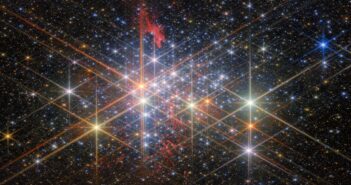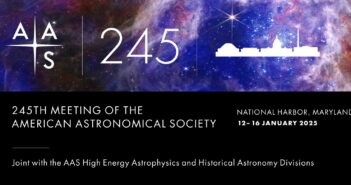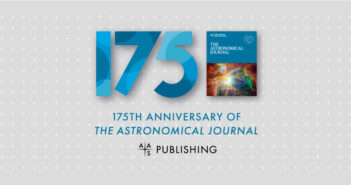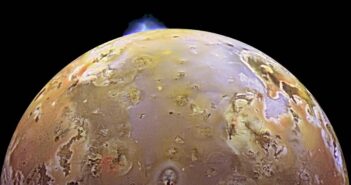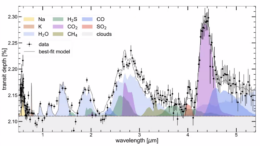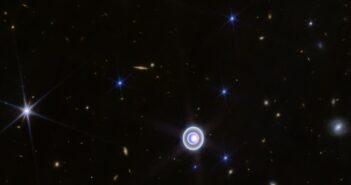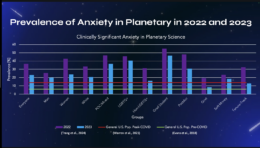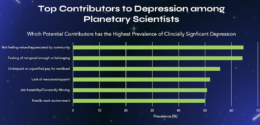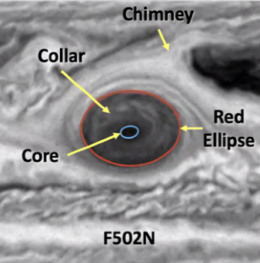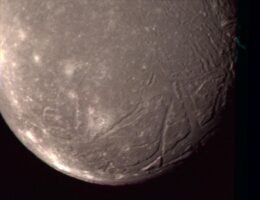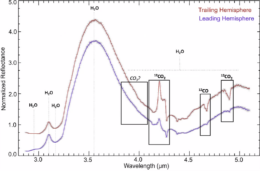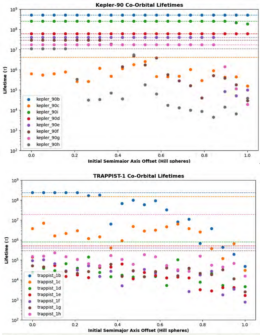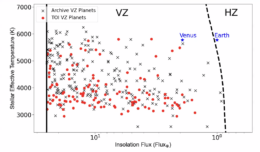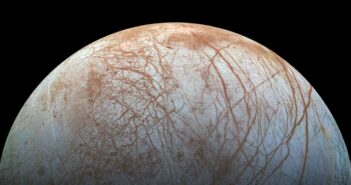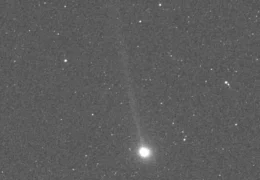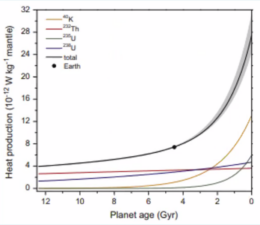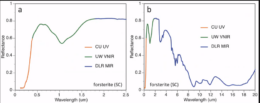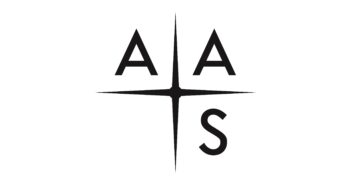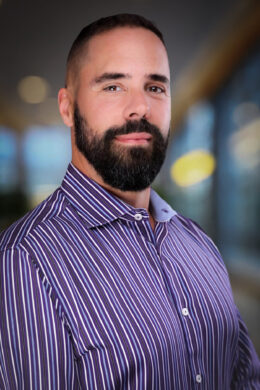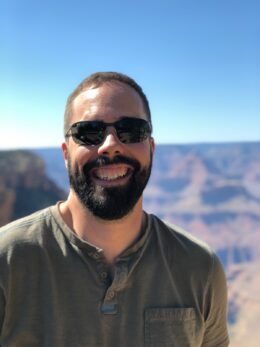
AAS 245: Day 2
Editor’s Note: This week we’re at the 245th AAS meeting in National Harbor, MD, and online. Along with a team of authors from Astrobites, we will be writing updates on selected events at the meeting and posting each day. Follow along here or at astrobites.com for daily summaries, or follow @astrobites.bsky.social on Bluesky for more coverage. The usual posting schedule for AAS Nova will resume on January 21st.
Table of Contents:
- Bronze Award for the University of Michigan from the Physics and Astronomy SEA Change Committee
- From the Smallest Things to the Greatest Results — The Incredible Power of the Chandra X-ray Observatory, Dave Pooley (Trinity University and Eureka Scientific, Inc.)
- Press Conference: Black Holes & New Outcomes from the Sloan Digital Sky Survey
- Henry Norris Russell Lectureship: The Cosmic Triangle: Probing the Dark Side of the Universe, Neta A. Bahcall (Princeton University)
- Press Conference: New Information from Milky Way Highlights
- Plenary Lecture: A Detector Backstory: How Silicon Detectors Came to Enable Space Missions, Shouleh Nikzad (Jet Propulsion Laboratory)
- Plenary Lecture: Annie Jump Cannon Prize Lecture: The Icy Origins of Planetary Systems, Jenny Bergner (University of California, Berkeley)
Bronze Award for the University of Michigan from the Physics and Astronomy SEA Change Committee (by Jessie Thwaites)
At the beginning of the morning’s sessions, Dr. Dara Norman (AAS President) announced that the University of Michigan Department of Astronomy has earned a Bronze Award from the Physics and Astronomy SEA Change Committee (read the AAS press release here). The award recognizes the University of Michigan Astronomy Department’s work towards understanding obstacles to diversity, equity, and inclusion in their community, in order to engage all members of their community. They have developed a five-year plan to address any issues identified in their assessment. The University of Michigan Astronomy Department is the first astronomy department to receive this award.
From the Smallest Things to the Greatest Results — The Incredible Power of the Chandra X-ray Observatory, Dave Pooley (Trinity University and Eureka Scientific, Inc.) (by Jessie Thwaites)
X-ray vision has long been considered a superpower — and the Chandra X-ray Observatory has that power! Dr. Pooley begins his talk by saying that summarizing the successes of X-ray astronomy, or even just those enabled by Chandra, is impossible in a mere 40 minutes. So, he set some of the Chandra greatest discovery images to one of his favorite great hits: Kermit the Frog’s Rainbow Connection. From intricate maps of our solar system, images of merging galaxies, and microlensed galaxies, to understanding of cosmic structures, Chandra has enabled incredible discovery over the past 25 years since launch.
But making these images, Dr. Pooley says, is more than detecting — it was designing and focusing an incredible instrument, and in particular, incredibly smooth mirrors. X-rays have to be focused at grazing incidence, otherwise they will pass right through the mirror, and any imperfection on the surface degrades our ability to focus the instrument. So at the time of Chandra design and development, the team designed the smoothest mirrors ever produced. If the mirrors were the size of Earth, Dr. Pooley says, the largest imperfections would be a mountain only a meter tall! This incredible feat of engineering has enabled the incredibly precise images that drive the cutting edge science done with Chandra.
Dr. Pooley goes on to highlight some of the amazing science done with Chandra. With its exemplary resolution, Chandra is able to resolve 100 times more sources in the globular cluster 47 Tucanae than its predecessor, ROSAT, and where ROSAT could not detect any sources in Messier 4, Chandra can detect around 100 of them. These new images allow the team to study the dynamics of the cluster and how binaries are forming inside them.
Chandra has also unlocked our current understanding of how particles are accelerated in supernovae, by resolving their gas structure. In a supernova, a forward-moving shock is propelled by the explosion into the gas surrounding the star, and a reverse shock pushes particles back toward the supernova. Electrons accelerated by the forward shock produce synchrotron radiation that has been imaged by Chandra, providing key evidence to describe how cosmic particles are accelerated in supernovae. It was also the first observatory to detect X-rays from the merger of two neutron stars in the multimessenger discovery of GW170817, showcasing its power as a time domain and multimessenger astronomy instrument.
The science that can be done with Chandra is not just monumental, it’s transformative. Imaging galaxy clusters with Chandra has also furthered our understanding of dark matter. Through Chandra imaging of the Bullet Cluster, which is unique in that it is actually the product of two colliding galaxy clusters, scientists can find proof of the existence of dark matter. While normal matter is subject to drag forces, dark matter is not, so the normal matter that emits in X-rays observed by Chandra is concentrated towards the center, while most of the mass of the cluster is concentrated farther away, as shown in the figure below.
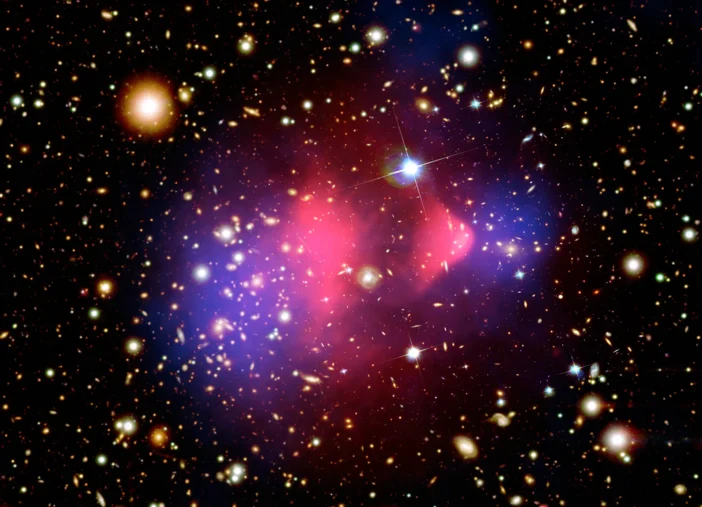
Image of the Bullet cluster by Hubble and Magellan telescopes, with a map of the normal matter (seen by Chandra, pink) and dark matter (blue) shown on top. [X-ray: NASA/CXC/CfA/M.Markevitch, Optical and lensing map: NASA/STScI, Magellan/U.Arizona/D.Clowe, Lensing map: ESO WFI]
Press Conference: Black Holes & New Outcomes from the Sloan Digital Sky Survey (by Lexi Gault) (Briefing video)
A Variable X-Ray Monster at the Epoch of Reionization (Press Release)
Lea Marcotulli (Yale University)
At the center of most galaxies in the universe lies a supermassive black hole. When these black holes are gobbling up galactic material, they become some of the brightest objects in our universe. Dr. Marcotulli announced X-ray observations taken with Chandra and NuSTAR of one such object, J1429+5447, which lies in the epoch of reionization — just 900 million years after the Big Bang. J1429+5447 is the brightest active supermassive black hole observed in X-rays at this distance and is the farthest source ever detected by NuSTAR. These observations reveal extreme X-ray variability, which is indicative of powerful relativistic jets coming from J1429+5447. This discovery provides the opportunity to study the relationship between supermassive black hole growth and jet-powering mechanisms.
JWST’s Little Red Dots and the Rise of Obscured Active Galactic Nuclei in the Early Universe (Press Release)
Dale Kocevski (Colby College)
Recently discovered with JWST, little red dots are red compact objects with unusual colors that have evoked many questions from astronomers. If these objects are galaxies powered by stellar light, they introduce the “over-massive galaxy problem” — these galaxies would be much too massive much too soon after the Big Bang given current cosmological theories and galaxy formation models. A new study, led by Dr. Kocevski, compiled a sample of 341 little red dots to further investigate these perplexing objects. They find that these objects exist primarily between redshifts of z~4 to z~8 and are more numerous than the expected number of quasars and X-ray active galactic nuclei in this range. Spectroscopy of these little red dots reveals broad emission lines, a sign of a fast-moving accretion disk orbiting an active supermassive black hole. Though these galaxies are primarily powered by supermassive black holes — solving the over-massive galaxy problem — further studies of these sources will help to understand how their central black holes formed and how the galaxy catches up to its black hole.
Revealing the Mid-Infrared Properties of the Milky Way’s Supermassive Black Hole (Press Release)
Joseph Michail (Center for Astrophysics | Harvard & Smithsonian)
Using JWST, Dr. Michail and collaborators have detected the first-ever mid-infrared flare from our galaxy’s central supermassive black hole Sagittarius (Sgr) A*. Over the past 30+ years, researchers have observed flares in Sgr A* at other wavelengths, but until this study, have yet to observe a flare in the mid-infrared. This new detection fills the gap between near-infrared and radio observations of flares in Sgr A* and provides a new view in understanding the microphysics responsible for the formation of flares.
Black Hole Archaeology: Mapping the Growth History of Black Holes Across Cosmic Time (Press Release)
Logan Fries (University of Connecticut)
With the Sloan Digital Sky Survey (SDSS) Reverberation Mapping project making mass measurements of hundreds of black holes, Fries and collaborators have been able to use these masses in conjunction with spectroscopic observations to measure the spin of a sample of black holes. The spin of a black hole is important as it encodes the growth history of the black hole. If a black hole builds its mass through accreting material, the black hole will spin up rapidly, and if a black hole builds its mass through mergers, the black hole will spin down. Through this study, they find that many black holes spin up quickly, and that black holes in more distant galaxies tend to spin up more than those in the nearby universe. This challenges the expectation that most black holes gain mass through mergers, and future observations with JWST will help to further understand how black holes have grown over time.
The SDSS-V Local Volume Mapper: Early Data and Science (Press Release)
Dhanesh Krishnarao (Colorado College)
SDSS has employed a set of four robotic telescopes to map the Milky Way’s interstellar medium to further understand how star formation occurs. Dr. Krishnarao presented the first data and science from the SDSS-V Local Volume Mapper (LVM), a survey aimed at taking spectra covering various emission lines for a large section of the Milky Way. These observations will allow scientists to observe individual stars’ impacts on the surrounding gas, which are key to understanding how galaxies form stars and evolve. Another important aspect of SDSS-V is its Faculty and Student Team (FAST) program, which provides support for students and faculty from minority-serving institutions to join the collaboration. The first data from LVM will be publicly available in data release 19 from SDSS.
Henry Norris Russell Lectureship: The Cosmic Triangle: Probing the Dark Side of the Universe, Neta A. Bahcall (Princeton University) (by Archana Aravindan)
For Dr. Neta Bahcall, the Henry Norris Russell Lectureship holds a special significance. Dr. Henry Russell played a significant role in establishing Princeton, where Dr. Bahcall has spent nearly 50 years, as a leading center for theoretical astronomy! Additionally, her husband Dr. John Bahcall was also awarded the lectureship in 1999, making them the first couple to win the award!
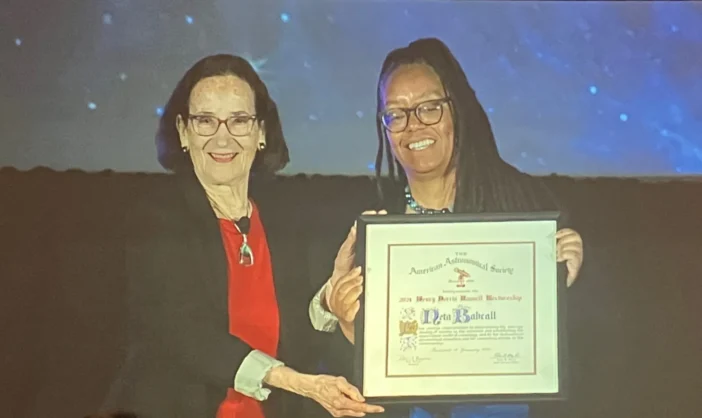
Dr. Neta Bahcall receives the Henry Norris Russell lectureship from Dr. Dara Norman, President, AAS.
Dr. Bahcall begins her talk by providing a brief history about how the concept of dark matter came about. In the 1970s, the accepted fraction of matter (Ωm) in the universe was believed to be 1, indicating that all the matter in the universe was accounted for. But several eminent astronomers, including Fritz Zwicky, did not think that was true. The concept of dark matter (or matter we cannot see) was already floating around, but few people believed in it. Dr. Bahcall and her collaborators set out to observationally determine the value of Ωm, helping us understand if there truly is mass that we cannot see! They did this in two ways:
- Cluster correlation function: This function indicates how clusters of galaxies are distributed in space. Dr. Bahcall found that this function was 20 times stronger than the galaxy correlation function (which indicates how galaxies are distributed in space!). This discrepancy indicates that we see a large-scale structure in the universe and implies that the distribution of all the mass is not just tracing the light. There must be some mass that is not accounted for and thus Ωm cannot be 1. Dr. Bahcall and her collaborators determined that the fraction of baryonic matter (matter that interacts with light) should instead be closer to 0.3, and there must be some other form of matter that is not tracing the light. This discovery swung open the door for several models of dark matter.
- Mass-to-light ratios: Additionally, Dr. Bahcall also made use of another method to confirm this new value of Ωm. She calculated the total mass present in a given region of space based on its observed luminosity, essentially providing an indication of how much matter exists relative to the amount of light we can detect. This ratio is called the mass-to-light ratio or M/L. Higher M/L ratios suggest that all the matter is just not contained in stars (which contribute to the luminosity) and a larger proportion of dark matter is present.
This led Dr. Bahcall to set up a figure known as the cosmic triangle, which is a way of representing the past, present, and future status of the universe. The most precise measurements of the three quantities confine the universe to a strip in the plot. The three strips overlap at the ΛCDM model, which is in best agreement with observations.
Dr. Bahcall also touches upon the recent state of the field and all the ongoing questions about where the dark matter is actually located. New results from the Sloan Digital Sky Survey indicate that the M/L ratio increases up to a certain limit and it flattens out as we eventually go to larger and larger scales. This shows that most of the mass in groups comes from dark matter in galaxy halos, and there is no need for any additional dark matter that fills the space between large clusters.
Throughout her lectureship, Dr. Bahcall stresses the beauty of doing science. “It’s about how we don’t understand where we are and go step by step to figure it out!” she says. She wraps up her talk by thanking her mentors, collaborators, and grad students, and by giving a moving tribute to her wonderful family and (late) husband.
Press Conference: New Information from Milky Way Highlights (by Lexi Gault) (Briefing video)
Infrared Echoes of Cassiopeia A Reveal the Dynamic Interstellar Medium (Press Release)
Jacob Jencson (California Institute of Technology/IPAC)

JWST’s near-infrared view of Cassiopeia A’s light echoes. Click to enlarge. [NASA, ESA, CSA, STScI, Jacob Jencson (Caltech/IPAC)]
A Path-Breaking Observation of the Cold Neutral Medium of the Milky Way Through Thermal Light Echoes (Press Release)
Joshua Peek (Space Telescope Science Institute)
The detailed JWST observations of the light echoes surrounding Cassiopeia A illuminate a prototypical piece of the interstellar medium, which has allowed Dr. Peek and collaborators to explore the properties of the cold neutral medium that makes up 40% of the gas in the Milky Way. From the images, the structure of the cold neutral medium appears to have bundles of longer filaments and knots, which are similar to structures seen in simulations of magnetized gas. Magnetized gas resists compression, but stars form out of cooling and compressing gas, so further studying these small structures in the cold neutral medium will aid in understanding how gas collapses to form stars.

Left: Hubble Space Telescope image of the Ring Nebula. Center: Radio emission from carbon monoxide molecules as seen by the Submillimeter Array. Right: Infrared image of JWST showing contours of the carbon monoxide molecules that are moving perpendicular to our line of sight. Click to enlarge. [NASA/ESA/O’Dell/Ferland/Henney/Peimbert/Thompson; SMA image and SMA/JWST image overlay: Joel Kastner/RIT]
Joel Kastner (RIT Center for Imaging Science)
The Ring Nebula is an iconic astronomical object, and despite its frequent stage time, the intrinsic 3D structure of the ring has yet to be fully understood until now. Dr. Kastner presented Submillimeter Array imaging of the Ring Nebula from which a 3D model of the nebula was created. The gas in the nebula appears in a clumpy ellipsoidal shell with holes on both sides, roughly the shape of a barrel. These holes are likely driven by a binary companion that created strong, high velocity outflows through the center of the shell. From this model, they find that the gas was ejected from the central star around 6,000 years ago. Uncovering the 3D structure of planetary nebulae, like the Ring Nebula, allows scientists to better understand the ending stages of intermediate-mass stars.
X-Ray Echoes from Sgr A* Provide Insight on the 3D Structure of Molecular Clouds in the Galactic Center (Press Release)
Danya Alboslani (University of Connecticut)
Similar to infrared echoes from Cassiopeia A, X-ray echoes from the Milky Way’s central black hole Sagittarius A* reveal the 3D structure of molecular clouds near the galactic center. Alboslani presented two decades of X-ray echo observations from the Chandra X-ray Observatory and the resulting 3D maps of two molecular clouds, the Stone and Sticks clouds, in the Milky Way’s central molecular zone. These clouds exist in an extreme environment with temperatures and densities much higher than elsewhere in the galaxy. Through comparing the X-ray observations to submillimeter wavelength observations of the same clouds, the duration of the X-ray flare can be constrained based on the gaps in structure shown in the X-ray imaging. They find the flare to be no longer than ~5 months. These 3D maps provide further insight into the conditions that lead to star formation in the central region of the galaxy.
Plenary Lecture: A Detector Backstory: How Silicon Detectors Came to Enable Space Missions, Shouleh Nikzad (Jet Propulsion Laboratory) (by Bill Smith)
Dr. Shouleh Nikzad began by expressing her belief that the development of any new technology goes through three phases: invention, innovation, and infusion. In her plenary talk, she discussed these three phases as they applied to the development of silicon detectors for the ultraviolet (UV) light spectrum. She began with an overview of why the UV part of the spectrum is critical for astronomy, noting the many electron transitions that can be seen in ultraviolet spectra and applications for understanding planetary atmospheres. However, detecting the UV spectrum presents unique challenges, notably that UV radiation is absorbed within a few nanometers of the surface it hits, which means the designers of UV detectors must have exquisite control over the surfaces they develop.
Dr. Nikzad then shared a few of the reasons why silicon specifically was used to develop UV detectors, including the widespread adoption of silicon technology in industry. This widespread adoption meant that the existing infrastructure for the technology already existed and that it could be scalable for the next generation of flagship telescopes.
To create these silicon detectors, Dr. Nikzad and her group use a technique called atomic layer deposition, which is a technique that can create a very thin film on a surface with a high degree of control over the thickness. By using this technique, they were able to develop silicon detectors that, for the first time, could count single photons in the UV spectrum. She then explained how they were able to develop a bandpass filter for these detectors that would enhance UV detection and reject visible light.
Dr. Nikzad concluded by providing a tour of missions and potential future missions using this technology, including the Zwicky Transient Facility, FIREBall-2 (The Faint Intergalactic Medium Redshifted Emission Balloon Telescope, SPARCS (the Star-Planet Activity Research CubeSat), and UVEX (the Ultraviolet Explorer).
Annie Jump Cannon Prize Lecture: The Icy Origins of Planetary Systems, Jenny Bergner (University of California, Berkeley) (by Lindsey Gordon)
Dr. Jenny Bergner received the 2024 Annie Jump Cannon Award, which is “for outstanding research and promise for future research by a postdoctoral woman researcher.” The award citation is for “…her innovative astrochemical work at the intersection of laboratory experiments, theory, and observations, which has established new pathways to interstellar chemical complexity.”
Dr. Bergner’s work focuses on the chemistry of stars and planets during their formation. Baby stars are surrounded by protoplanetary disks, which are flattened disks of material that have a high enough density to clump together into planetesimals. Planetesimals are solids that are too small to be planets but are large enough to be held together by gravity.
These disks are a window into the chemical building blocks of planets. Three categories of material make them up: dust, ice, and gas. But these materials aren’t like their Earth analogs. Dust is composed of refractory materials: materials that remain solid at high temperatures. Ice is the layer of frozen volatiles — materials that vaporize at high temperatures —that stick to the dust. The ice isn’t all water, and it doesn’t have the crystalline structure that Earth ice does, but rather an “amorphous fluffy structure” with lots of nooks and crannies. The gas is any molecule not frozen out into the ice, and the gas is at the very low temperature of ~10K [−441.67℉ / −263.15℃].
There are lots of questions about these materials that are only now able to be answered. How much of each material is present and the chemical breakdown of each material will affect the kinds, properties, and atmospheres of the resulting planets. Whether or not the planets that form will be hospitable to life is an even harder question that depends on the presence of biogenic elements (C, H, O, N, S, P), which are the building blocks for life on Earth.
The Atacama Large Millimeter/submillimeter Array (ALMA) has allowed astrochemists to measure the substructure of the composition of protoplanetary disks. The ALMA-MAPS program looked at the millimeter-size dust grains’ emissions for different molecular line data. However, ALMA is only good at looking at gas and dust, but not ice. Most volatiles are in the ice, which meant we weren’t able to constrain their properties until JWST came along.
JWST is able to observe edge-on protoplanetary disks, which allows us to measure the central star’s light as it passes through the disk. This allows us to determine the disk composition including the ice. In an early JWST observing program of the HH 48 NE disk, they found evidence for H2O, CO2, and CO, but they needed to produce spectra in the lab for comparison.
Because space ice is so different from Earth ice, Dr. Bergner’s group uses a highly specialized cryogenically cooled vacuum chamber to form analogs of space ice for study. They take spectra of samples to try and match the JWST observations. They also do full radiative transfer modeling of how the photons moved through the disk in order to properly reproduce the observations.
From this work, they were able to differentiate between possible scenarios, and found that there are different regions in the disk where H2O, CO, and CO2 all interact (“polar” regions) and regions where only CO and CO2 interact (“apolar”). They were also able to measure the C/O ratios in the icy solids and found lower values than expected based on previous protostellar ice inventories. This is only one system, of course, but this is exciting for future work. JWST has already observed or is scheduled to observe 12 edge-on disks that will allow the team to explore disks as a population.
Dr. Bergner also highlighted the need for far-infrared observations. Water’s emission line, cool-warm gas phase water lines, and gas tracing for the total disk mass are only possible with far-infrared spectra. The proposed PRobe Far-Infrared Mission for Astrophysics (PRIMA) mission is still conceptual, but if approved, it would fill in this gap.
The JWST spectra also show the presence of more complex molecules, the formation and fate of which was not known. Her group investigated excited-state oxygen atom chemistry, where ionized oxygen can react with hydrocarbons to form organic molecules. This reaction has no activation barrier, but it might not be stable. In a lab setting, Dr. Bergner’s team found that this process can make complex molecules at 10K, and that this process is broadly applicable to form many different molecules.
She then focused on what happens to these molecules once they’re formed. Making a planet is violent, and we don’t expect complex molecules to survive the formation process. It seems likely that complex molecules are delivered later through impacts by icy planetesimals. This is backed up by looking at planetesimals in our own solar system — like comets and asteroids — which also have chemical complexity that dates back to the solar system’s formation. Her group modeled the survival of ice in disks, and found that comets may form further out in the disk before drifting inward to smaller radii, which protects the ice.
2017’s visit from Oumuamua was the first time we had the opportunity to study a planetesimal from another system. It also had a big mystery — it was moving faster than we would expect under purely gravitational conditions. But it wasn’t aliens — it was likely due to outgassing (ejection) of material giving it a boost, similar to what comets are known to do. What gas it was releasing was hard to pin down. There was no evidence for carbon-based gases, and the amount of solar energy it received wasn’t enough to cause it to release water or CO2. This left a small list of possible materials.
Dr. Bergner studied hydrogen as an option. The theory was that Oumuamua was a comet coming towards us, and radiation hitting water molecules created molecular hydrogen that got trapped in the nooks and crannies of the amorphous ice. When our Sun heated the remaining water ice, it crystallized into a lattice structure and the hydrogen escaped and boosted Oumuamua’s velocity. This turns out to be a viable option for the gravitational boost, as there is a large parameter space where it would work and the amount of solar energy it received is enough to have made the ice into a lattice.
Dr. Bergner’s work sits at the intersection of observations, experiments, and theory. The field of protoplanetary disks and planetary system formation has a bright future with JWST and potentially the far-infrared PRIMA mission.
